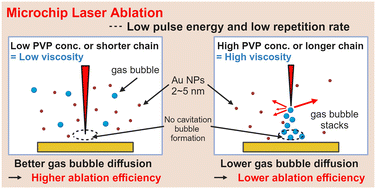Uncovering gold nanoparticle synthesis using a microchip laser system through pulsed laser ablation in aqueous solution†
Abstract
The synthesis of gold nanoparticles (Au NPs) was carried out by utilising the pulsed laser ablation in liquids (PLAL) method with a microchip laser (MCL) system. This portable system features low power consumption and a giant-pulse laser. Aqueous solutions with and without the surfactant poly(N-vinyl-2-pyrrolidone) (PVP) were used for laser ablation of a bulk gold rod to achieve the successful formation of a colloidal solution of Au NPs. The gas bubbles formed by heating the aqueous medium around the surface of the gold target significantly reduced the efficiency of Au NP ablation. This effect was more pronounced and prolonged in high-viscosity solutions, hindering energy transfer from subsequent laser pulses to the target. Additionally, it was suggested that the chain length of PVP does not affect either the size of the Au NPs or the ablation efficiency. Videography experiments were conducted to explore the ablation mechanism employed by the MCL system. The relatively short pulse duration of the MCL system may contribute to the formation of NPs with consistent size, which were suppressed to grow in significantly smaller cavitation bubbles with short lifetimes.
Keywords: Pulsed laser ablation in liquids (PLAL); Microchip laser (MCL); Gold nanoparticles; Viscosity; Poly(N-vinyl-2-pyrrolidone) (PVP).



 Please wait while we load your content...
Please wait while we load your content...